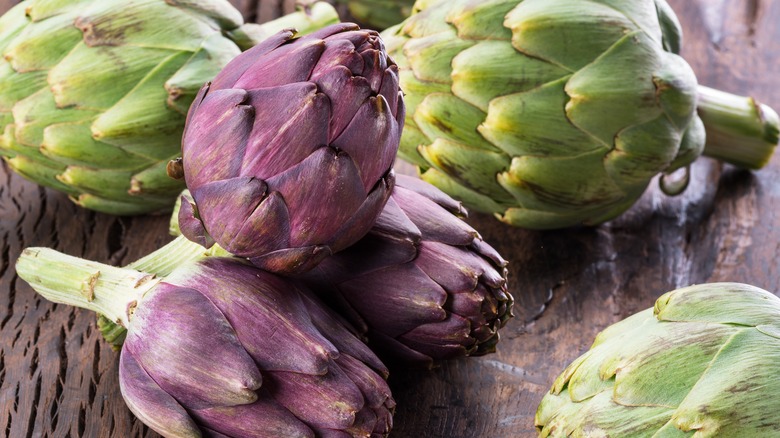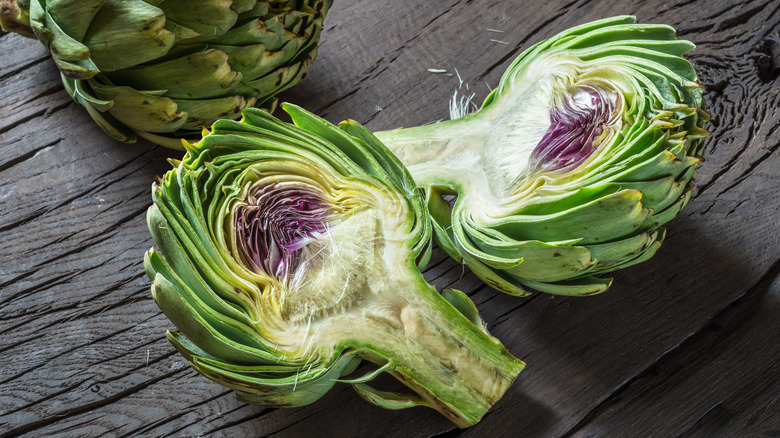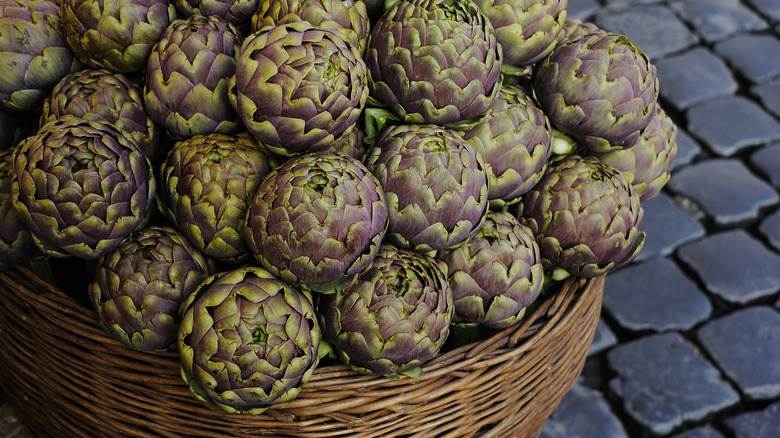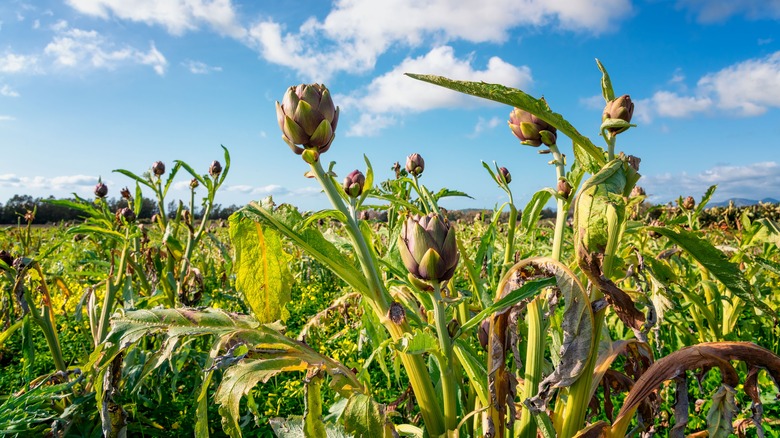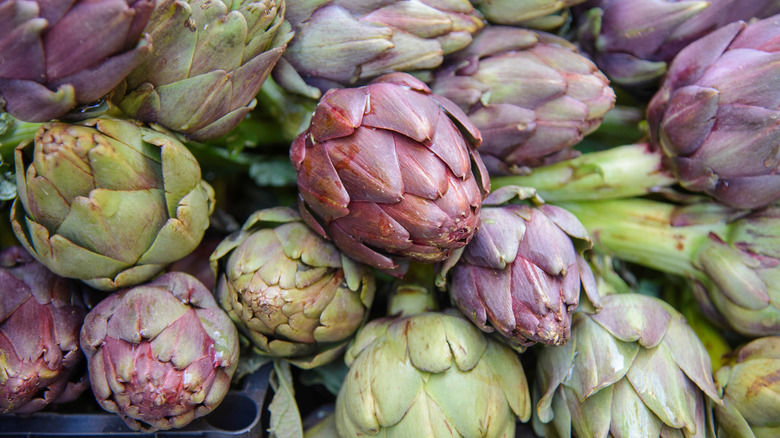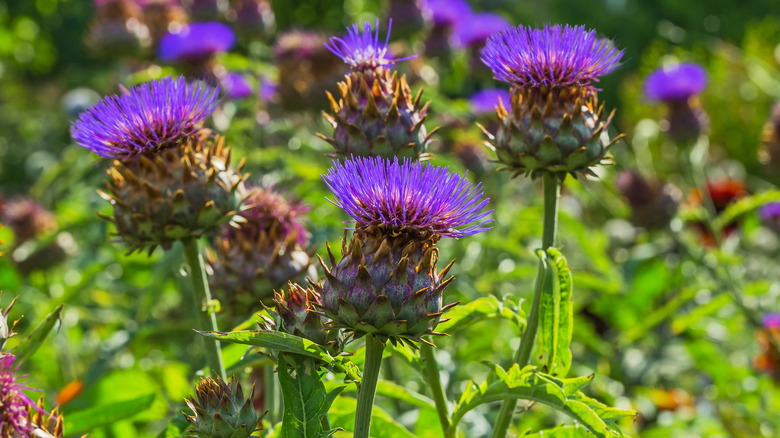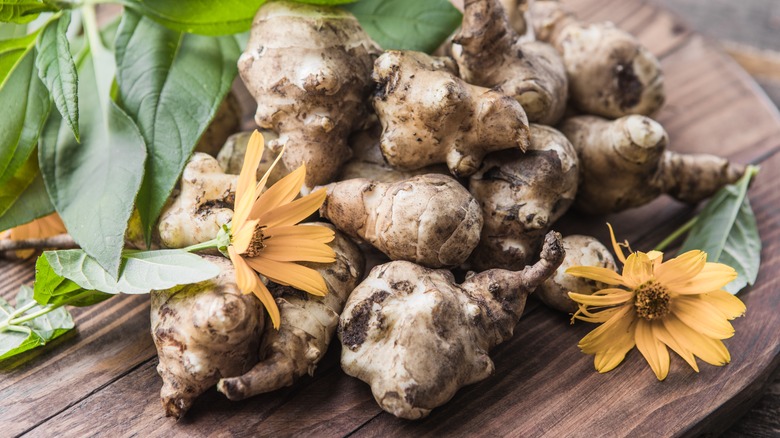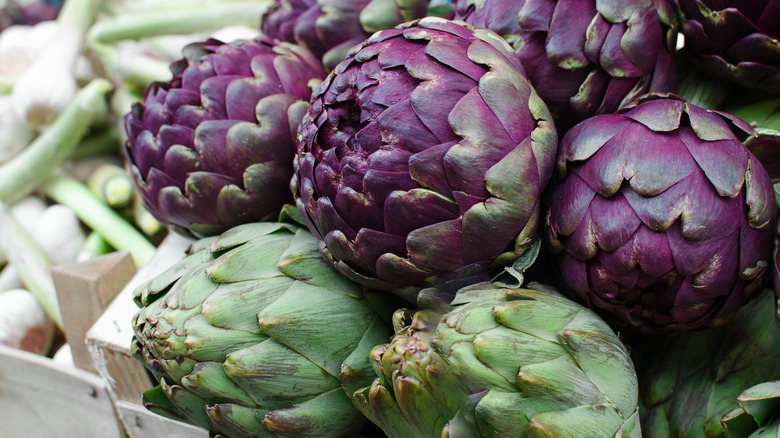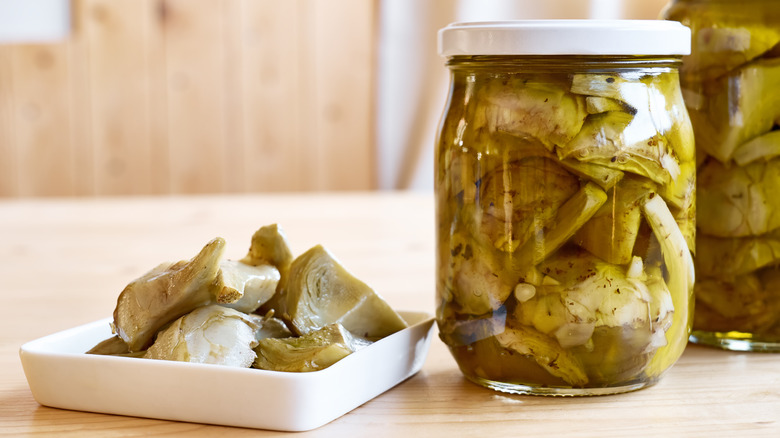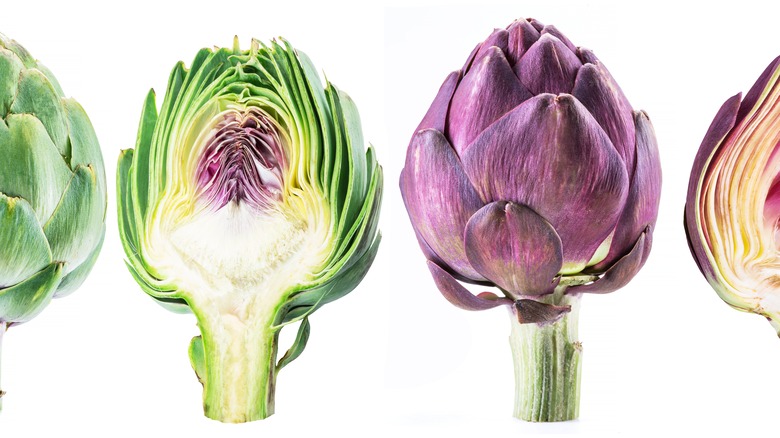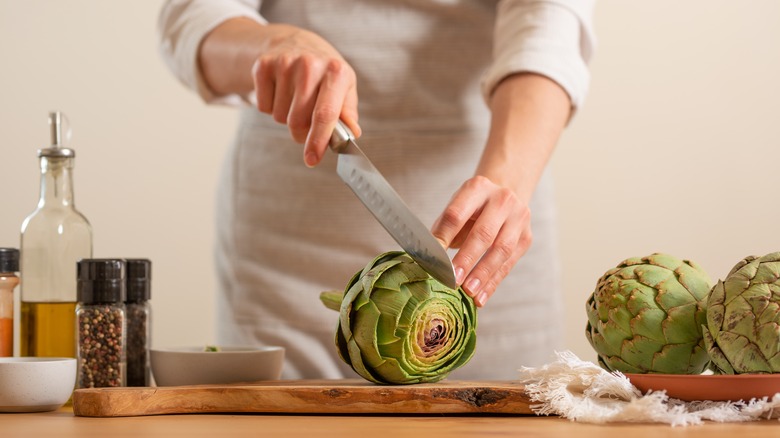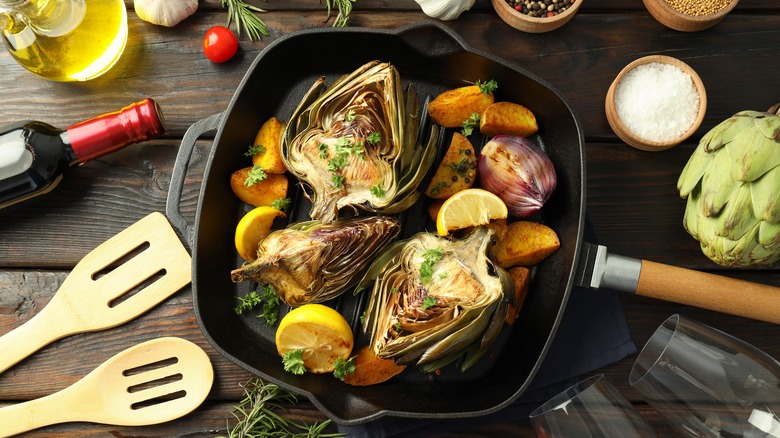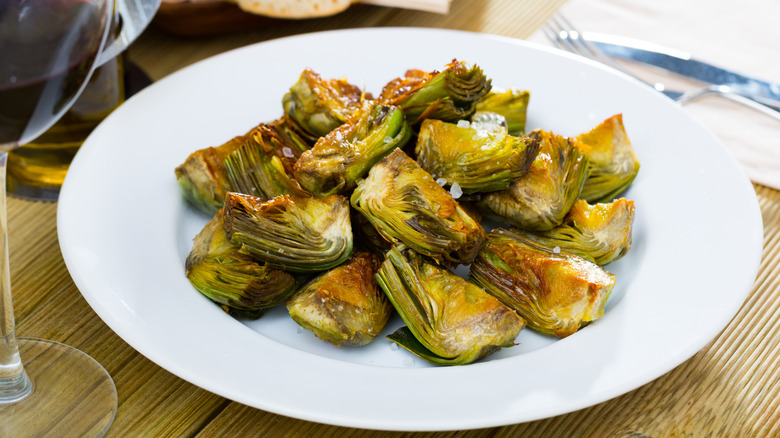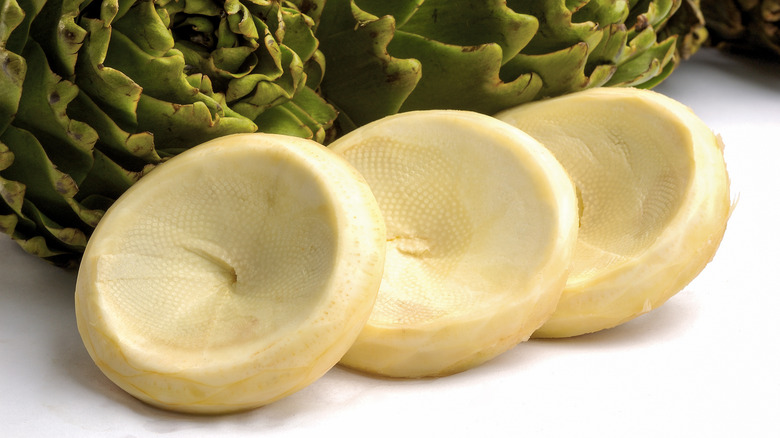The Ultimate Guide To Artichokes
Artichokes (Cynara cardunculus) can be mysterious vegetables, and fresh varieties are somewhat daunting to prepare if you've never cooked them before. The tender heart of the produce is surrounded by leafy armor, guarded with sharp thorns, and topped with a fluffy "choke" that can cause serious problems if accidentally eaten. Naturally, many things can go wrong if you don't know how to prepare or consume artichokes correctly. However, there are plenty of benefits to gain as long as you have the right tools and knowledge at your disposal. Thankfully, it's easy to purchase artichokes that have been pre-trimmed and either frozen or canned, which can take away all the hard work involved in cooking them.
Not only is this vegetable delicious and versatile, but it also has a multitude of health benefits (via Healthline). If you've been wanting to prepare them at home but feel like you don't know where to start, this article is for you; it has all the information you need to become an artichoke pro.
What are artichokes?
The English word "artichoke" is derived from the Arabic word for the plant: al-karsufa (via National Geographic). According to the Wisconsin Department of Public Instruction, this vegetable is the edible flower bud of a kind of thistle related to sunflowers. It is a descendant of a wild plant native to North Africa. Depending on the variety of artichoke, its size can range from 2 to 4 inches in diameter (per California Artichoke Advisory Board). Different types may be green, purple-tinged, or completely purple.
All artichoke varieties share the same basic structure. According to National Geographic, most of the vegetable is made up of a cluster of bracts; these are the outer leaves of the bud, and they usually have thorns on their tips (via Ocean Mist Farms). The bracts surround the inedible choke of the plant, which looks like a white puffball. The choke is what turns into the petals of an artichoke flower if the bud is allowed to bloom fully. This fluffy bit sits on top of what's arguably the tastiest edible part of the vegetable — the heart — which is the soft, bottom part of the bracts. Artichokes are usually sold with a bit of the stem attached, which can also be consumed as long as the exterior is removed.
Artichokes in history
Artichokes were quite popular during the Roman Empire (via National Geographic). The Romans believed that the plant had a whole host of medicinal uses. They even made an appearance in Roman mythology: According to the lore, Zeus created them when a woman named Cynar, who he had been having an affair with, tried to cut things off. Of course, this made Zeus mad, so he turned the unfortunate Cynar into an artichoke.
Like many aspects of European culture, artichoke appreciation was lost for a few centuries in the continent after the Roman Empire fell, but came back into fashion during the Renaissance. The preparation of this vegetable became popular across Florence and France (perhaps with the help of Catherine de Medici), and soon, other European countries followed.
European colonists eventually brought artichokes to the new world. The vegetable could be found in the gardens and kitchens of at least two founding fathers: George Washington and Thomas Jefferson. However, the produce didn't really catch on in America until Italian immigrants began planting large-scale artichoke farms in California in the early 20th century (via Wisconsin Department of Public Instruction).
How are artichokes produced?
According to the California Artichoke Advisory Board, almost all U.S. artichokes are grown in California; the farms in the state's Castroville area grow the majority of them because the mild climate is well-suited for their production.
Artichoke plants can measure about 6 feet across and up to 4 feet high when fully grown. It takes about a year for them to start producing edible buds (via Wisconsin Department of Public Instruction). Workers then harvest the artichokes by hand, cutting the buds off the stalks with knives and depositing them into specially-designed packs they wear on their backs. Afterward, the collection is dropped off at packing machines, usually parked in the fields during harvesting season. Inside the machines, the artichokes move through a conveyor belt as more workers sort them by size to fill boxes. Finally, the packaged produce is washed before it's shipped to grocery stores.
Types of artichokes
Per NPR, the majority of artichokes sold in American grocery stores are of the "globe" variety. This is the type you probably imagine when you try to picture the vegetable in your head; it's dark green, medium in size, and has tightly-packed leaves topped with thorns. However, this is just one of many artichoke varieties you might come across.
Purple artichokes look beautiful and have a rich flavor, but they come from a unique crop that's not available year-round (via Ocean Mist Farms). If you're lucky, you might be able to get your hands on baby artichokes, but despite their name, they're not actually babies. They're a special breed of artichoke that stays small even when fully mature. This variety is super convenient because almost the whole vegetable is edible, and doesn't contain a choke. Per Specialty Produce, you can sometimes buy thornless, full-sized artichokes, although you may find them to be less flavorful than the standard ones.
Beyond the common varieties from California, there are other artichoke breeds around the world. One you may find in the U.S. is called the Big Heart; this green artichoke is bred, as you might expect, to have an extra-large heart. In contrast, various Italian and other European artichoke breeds range widely in size and often have purple-tinged leaves.
Artichokes vs. cardoons
According to National Geographic, artichokes are actually one of two thistles bred for human consumption. The other edible thistle is known as a cardoon. Just like artichokes, cardoons were popular in Roman times and are eaten a lot in Italy today. They grow wild in many places close to the Mediterranean Sea, but you can also buy the vegetable cultivated (via Smithsonian Magazine). However, don't expect them to come cheap; farmed cardoons are blanched while they grow (that is, covered so they don't go through photosynthesis). This makes them more tender, but also more difficult to produce.
When you eat cardoons, you consume the stem of the plant. However, you'll have to peel the exterior layers off to reveal the edible section inside first. You can eat the vegetable raw, but cardoons are somewhat naturally tough and fibrous, so they benefit from being poached or braised until they're fully tender. They taste like artichokes, but a little more bitter.
Artichokes vs. Jerusalem artichokes
It's easy to assume that Jerusalem artichokes are a variety of this vegetable — perhaps one grown in the vicinity of the city. Of course, plant names don't often make sense, and this breed (also known as the sunchoke) actually has very little to do with artichokes or Jerusalem.
According to BBC GoodFood, sunchokes are actually the tuber of a specific variety of sunflowers. They look rather gnarled and knobby, with brown skin and white flesh. If they weren't labeled, you might mistake them for ginger because of the way they look, though they taste nothing like it. Instead, they're a starchy, crunchy root vegetable with a sweet, nutty flavor. The "Jerusalem" part of their more formal name is a garbled form of the word "girasole," which is Italian for "sunflower."
Sunchokes are versatile and can be cooked the same way you'd cook any other root vegetable. If you're looking for specific ideas for how to prepare them, we have a zesty bread and butter pickled sunchoke recipe as well as a roasted sunchoke with brussels sprouts recipe.
Where can you buy artichokes?
Fresh artichokes are often available in the produce section at normal supermarkets (via NPR). You can buy them throughout the year, but they're at their best between March and May. Canned and marinated artichokes will likely be shelved next to the other canned vegetables in the store.
As with many produce selections, a good artichoke should be heavier than it looks. NPR writes that a good test of artichoke freshness is to squeeze it — if you hear a squeak, that's a fresh artichoke. It should also have a vibrant and healthy green color, and tight leaves. If the outside of the vegetable looks dry, it's past its prime. Ocean Mist Farms also says that fresh artichokes should be firm.
Once you bring them home, you should cook them relatively quickly, though you can store artichokes in the fridge in a plastic bag for up to a week. Trim the end of the stem and wet it with water to help keep the vegetable fresh during storage.
Fresh artichokes vs. canned artichokes
At the store, you will be confronted with myriad options for buying these vegetables. There will likely be fresh options, as well as several types of preserved ones, including canned, marinated, and frozen artichokes (via University of Wyoming).
The fresh vegetable is delicious, but it can be a pain to prepare and might cost more than getting it already preserved. That's why, most of the time, you might want to buy canned artichokes instead of fresh ones. All the inedible bits have already been trimmed off of the packed versions, leaving only the hearts. However, they do taste a little more sour than fresh artichokes, as they're packaged with a small amount of citric acid. If you want something closer in flavor and texture to the fresher option, try to find frozen artichoke hearts; they're just as convenient as the canned ones.
Marinated artichokes are packed in cans or jars, but what separates them from standard canned versions is that they're already seasoned with a tangy marinade. Ultimately, all types of this vegetable are worth buying, but what you choose depends on what you intend to use them for and how much effort you feel like putting into meal prep.
Artichoke nutritional information
Although we no longer think of artichokes as medicine as the ancient Romans did, we can still appreciate their many health benefits. These vegetables are light on calories and quite nutritionally dense. According to Good Housekeeping, one artichoke is only 60 calories and contains about 4 grams of protein and 7 grams of fiber (a fourth of the recommended daily value). Some of the fiber in the produce is a prebiotic called inulin that can help maintain the health of your gut microbiome.
On top of the healthy macronutrients, artichokes also deliver doses of various vitamins and minerals, including vitamin C, iron, calcium, and potassium. The bracts contain flavonoids that act as antioxidants. Additionally, the beneficial compounds in this vegetable may have positive effects on liver, cardiovascular, and digestive health.
If you're looking to reap the rewards of consuming this vegetable in a more concentrated form, you can buy artichoke leaf extract as a health supplement; however, take care when dosing, as its effects have not yet been scrutinized by the FDA or large-scale studies.
How to cut an artichoke
If you'd rather not go through the process of plucking and scraping your way through a whole artichoke, you can also trim all the inedible bits off a fresh one and cook only the tender heart. It's a little bit more complicated than prepping most vegetables, but it's not hard if you have the right technique down.
Fortunately for you, we have our very own guide on how to cut artichokes (complete with handy illustrations). However, the gist is that you trim off all the tough outer bracts and the tips of the tender inner leaves, getting rid of all the thorns. Then, peel the hard skin off of the stem and base of the artichoke, leaving only the most tender, delectable parts of the vegetable.
The most important thing to remember when trimming artichokes is to completely remove the choke. It might look like a harmless puffball, but it's called the choke for a reason: You can really choke on it (via Gardening Channel). To get rid of it, simply split the vegetable down the middle and then scoop out all the fluff with a spoon.
Sliced artichokes start browning soon after they're cut; to minimize this undesirable color change, submerge them in cold lemon water after you're done trimming.
How to cook artichokes
Boiling is the easiest way to prepare whole, fresh artichokes since you don't have to trim them as much as with other cooking methods. You can accompany them with a sauce to dip the leaves into as you eat (via Lemon and Vine).
If you want to try something different with the fresh produce, our grilled artichokes recipe will add a fun twist to your next backyard barbecue. First, trim the artichokes, steam them to make them soft, and then char them on a hot grill. Serve the vegetables with grilled lemon wedges for a fun side dish.
Of course, you don't have to go to the trouble of cooking fresh artichokes. Our spinach artichoke sandwich recipe makes excellent use of their marinated hearts. It takes the basic components of a classic spinach artichoke dip and turns them into a delicious sandwich served on a crunchy baguette.
That's just the beginning of what you can do with these vegetables. Crispy fried artichokes rival french fries in terms of craveability. Canned or marinated artichokes are wonderful additions to pastas, pizzas, and bruschetta. Once you start experimenting with this ingredient, you'll find all sorts of delicious uses for it.
How to eat artichokes
The outer bracts of a whole, cooked artichoke are partially edible (via University of Wyoming). Although you can easily find pre-trimmed hearts served on their own, the vegetable's leaves are quite tasty as well. Per Ocean Mist Farms, unless you bought a thornless artichoke variety, you need to watch out for the spiky thorns at the tip of each leaf, but other than that, eating them is quite simple.
The outer edge of each bract is tough and inedible, but it hides a tender, delicious piece of artichoke flesh at its base. An NPR essay goes through the procedure for eating its leaves: Grab them one by one, placing each in your mouth upside down. Using your hands, pull the leaf out of your mouth while scraping the artichoke flesh away with your bottom teeth. Continue this process for each bract until you get close to the artichoke heart. At this point, trim off the choke — if it's still attached — and dig into the heart.
What do artichokes taste like?
The taste of artichoke is a little bit hard to describe. It's not a strong flavor, but it is unlike other vegetables, and it changes a lot, depending on how it's prepared. Lemon and Vine notes that they are slightly bitter when raw. In contrast, cooking unlocks the vegetable's herbal character and produces a more nutty, earthy result. The closest comparison in flavor might be brussels sprouts or asparagus — but really, artichokes just taste like artichokes.
Since the base flavor of this vegetable is so delicate, how you prepare it really matters. If you want to enhance its nuttiness and give it a caramelized flavor, frying it is a good way to go. If you're trying to appreciate the pure taste of the produce, boiling might be the preferred cooking method. Marinated artichokes fit the bill if you're craving something tart and refreshing.
Regardless of what you want the vegetable to taste like, you'll want to be careful if you decide to pair it with a glass of wine. According to the University of Wyoming, there's a flavor compound in artichokes that makes the alcoholic beverage taste worse.
